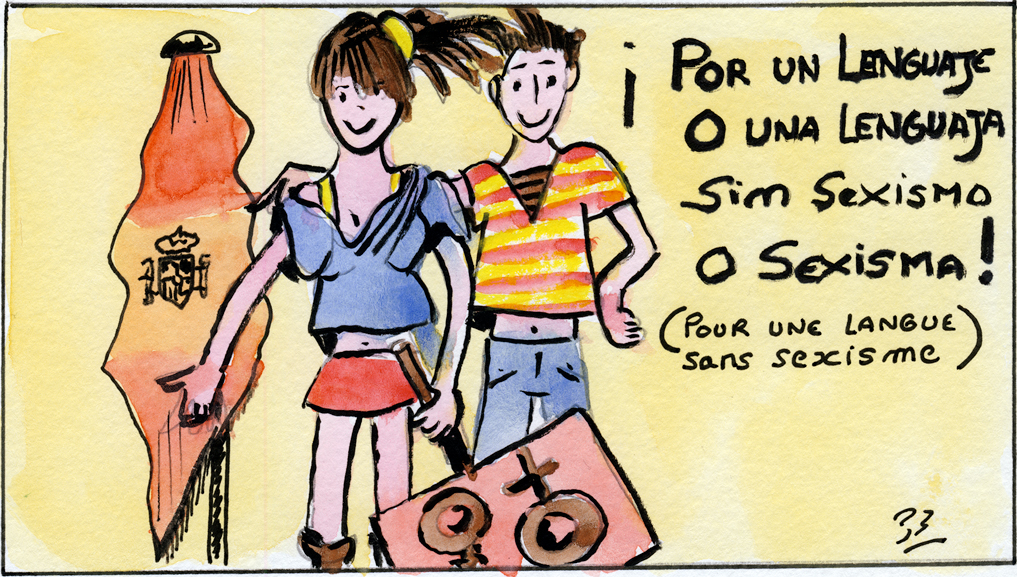By Carmen Chang,
As Marina Yaguello reminds us, language acts as a “cultural mirror”, capturing symbolic representations and echoing prejudices and stereotypes, thereby perpetuating them. Accustomed to speaking our language since birth, we often remain unaware of the phenomena that invisibilize and devalue women within it. Highlighted are the “small rules” and semantic peculiarities that contribute to pervasive sexism.
Sandra Roubin (2017), in her work “Le sexisme dans la langue française” (The sexism in the French language), brings attention to these issues.
To conduct this research, we identified a central theme or problem that allowed for a detailed analysis of gender in relation to language. This study emerged from the theme “Language and Gender” proposed within the framework of the Seminar on Hispanic and Roman Linguistics, titled “Can a language be sexist?” Methodologically, our focus was primarily on the Spanish language, though we included examples from other languages and references to various cultures depending on the topic and context.

Following our study and critical analysis of the issue, we arrived at several conclusions. Firstly, the use of the generic masculine form is the primary expression of linguistic androcentrism. According to Marina Subirats (cited by Mayte Rius, 2014):
language as our mental representation of the world makes it crucial to explicitly name women when speaking, since if we do not name them, we usually forget their existence and the difference it makes to be a woman or a man in many aspects.
This problem is clearly the first hurdle to overcome, but as we have outlined, there are other obstacles that must be addressed, and the path forward does not seem quick or easy. Efforts toward using more inclusive language are not solely related to the feminist movement but concern us all. These proposals imply acknowledging that women deserve equal treatment, and their implementation promotes the visibility and inclusion of women in society:
[…] for non-sexist use. As Moreno Cabrera points out, in this case, linguistic intervention is fully justified. But it is a restricted scope. There is no danger of spreading any kind of ‘feminist virus’ to everyday language. Linguistic changes always occur as innovations that depart from traditional models. […]. It will be the use by speakers that serves as the selecting criterion to choose one of them and establish it for its communicative effectiveness. Neither recommendations from guides, nor prescriptions, nor lectures will manage to impose or halt changes, just as it is not possible to force the course of a river’s waters…, nor stop it either.
Secondly, over time, certain terms commonly used by people are eventually assimilated and accepted by academies. It is not surprising that expressions like “azafato” (“flight attendant” or “steward” for male) have been formally incorporated into the dictionary after continuous use by speakers. In 2012, the Royal Spanish Academy published “Linguistic Sexism and Visibility of Women”, aiming to address some of the related aspects. However, this institution generally shows limited collaboration in accepting changes proposed by guidelines for non-sexist usage or linguistic modifications that do not arise from the language’s slow evolution.
Observing this lack of acceptance in some areas underscores how restructuring established models and patterns requires society to become aware and adopt lexicons, structures, and ideologies that favor women’s inclusion and gender equality.
Lledó asserts that one constant in any language is its ease in accepting new words to describe new realities or assessments, as well as its ease in shedding daily usage of words when they are no longer necessary. If society becomes aware of the importance of correcting sexist language quirks, new formulas will eventually emerge.
Thirdly, profound changes in language require very long periods of time. In the meantime, it is necessary to seek alternatives and less exclusionary ways to name women. In this same line of accepting change, García Meseguer (1991: 333, cited by María Márquez, 2013: 1922-1933) adds that:
“this custom will take root in the collective unconscious of Spanish speakers. As this happens, the aforementioned phrases will stop hiding women, as the identification of man with male is diluted. Such changes require lengthy periods of time; meanwhile, we see no problem in seeking alternatives, naming methods where women truly feel included.”
Additionally, in the article “Langues et cité” (Languages and city) (2013: 1) focusing on “Language and ‘Transgender’ Practices,” it highlights that just as linguistic sexism exists, discrimination related to sex and gender also exists:
People identifying as “transgender” claim an identity positioning that challenges the binary “man vs. woman”. Research on relationships between transgender practices and language is extremely rare but particularly interesting in illustrating how linguistic creativity is solicited to mark an identity positioning.

Regarding this, we can add the contribution of María Luisa Femenías (2010: 174-175) in the section titled “Intersected Identities: the ‘ethnic’ issue” from the book “Historia y pensamiento en torno al género” (History and Thought on Gender). She refers to other prejudices related to sexism, racism, and discrimination in various cases:
The defense of “ethnic” identity has a strong precedent in the Combahee River Collective Statement (Boston, 1977), which also coined the concept of “identity politics”. Its authors defined themselves —in the first person plural— as a collective of Black feminists, who gathered from 1974 onwards to define, clarify, and politically engage —in contrast with other progressive groups— in denouncing their oppression as women and as “Black” […] Their motivation stemmed from the disillusionment of realizing that legal reform was not enough, which led them to develop strategies to dismantle racism, classism, sexism, homophobia, etc., present across various structural levels of society. They base their proposals on the concept of “identity.” That is, the foundation of their demands and struggles is to “be Black women”; not as a biological product but as a result of socialization and education received. In other words, from the hetero-designated place that society confined them to. From a socialist perspective, they acknowledge fighting alongside progressive Black men against racism, as well as alongside other women against sexism in general.
In conclusion, the visibility of women not only reaffirms their existence and presence but also involves leaving behind the historical past, in which women were subordinate or subjugated by men. This is a battle for everyone that begins with linguistic education, the awareness of speakers, tolerance for change, and the gradual approval and implementation of the most coherent proposals accepted by society at large. There is still a long way to go, but more and more of us are contributing our part to this fight for equality and justice.
Finally, we include a citation from Sara Vecchiato (2004: 2-3) on “Le sexisme dans le langage. Notes sur l’italien et le français” (The sexism in language: Notes on Italian and French), which responds to the topic under debate in our research “Can a language be sexist?”:
Language is integral to all cultural life. In its sociolinguistic and discursive pragmatic dimensions, it is not surprising to find the same discriminatory mechanisms present in society. If certain ethnic groups or people in certain professions are scorned, this contempt will manifest through derogatory appellations or the sanctioning of their way of speaking… Language can indeed convey discriminatory and racist attitudes. Women have long been — and still are in several countries — disadvantaged subjects. Language can only express this state of affairs. However, it is more difficult to assert that language itself is sexist and that linguistic mechanisms reflect a misogynistic culture… The hypothesis that language is primarily a reflection of thought has been put forward, among others, by Edward Sapir in 1921 (and earlier by Plato). This idea has somewhat allowed Damourette & Pichon (1911-1927) to discuss sexual metaphor — or in their terms, ‘sexuisemblance’ — as the basis for the use of morphemes and the assignment of gender to inanimate beings… In essence, Damourette and Pichon rely on two deeply rooted stereotypes in Western culture: the active male and the passive female… A language ‘declined in the masculine’, made by and for men.
References
- Le sexisme dans la langue française. agir par la culture. Availiable here
- El sexismo que ocultan las palabras. La Vanguardia. Available here
- Maria del Pilar Márquez González. “Género gramatical y discurso sexista”. Sintesis. Madrid. 2013.
- Féminin, masculin : la langue et le genre. L & C. Available here
- Montserrat Huguet Santos, Carmen González Marín, Montserrat Huguet Santos [et al.]. “Historia y pensamiento en torno al género.: Kóre”. Editorial Dykinson, S.L.. Madrid. 2011.
- Lezione: Le sexisme dans le langage. Notes sur l’italien et le français, C.I.R.S.De – Università degli studi di Torino, Corso on line – Introduzione agli studi di genere Modulo di II Livello – Linguaggi e discriminazioni. Università Ca’ Foscari di Venezia. Available here




